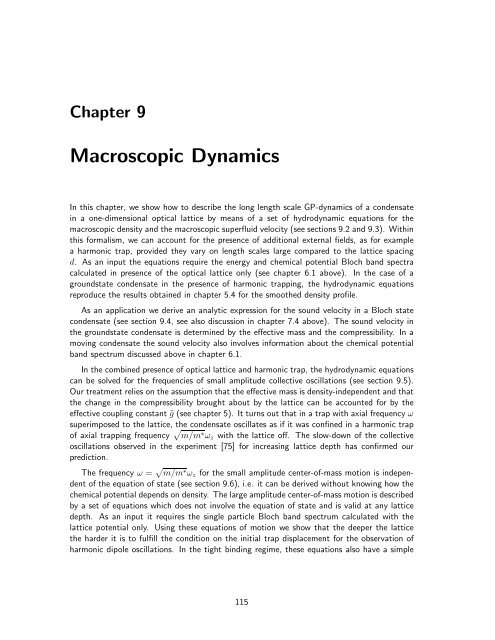Bose-Einstein Condensates in Rotating Traps and Optical ... - BEC
Bose-Einstein Condensates in Rotating Traps and Optical ... - BEC
Bose-Einstein Condensates in Rotating Traps and Optical ... - BEC
You also want an ePaper? Increase the reach of your titles
YUMPU automatically turns print PDFs into web optimized ePapers that Google loves.
Chapter 9<br />
Macroscopic Dynamics<br />
In this chapter, we show how to describe the long length scale GP-dynamics of a condensate<br />
<strong>in</strong> a one-dimensional optical lattice by means of a set of hydrodynamic equations for the<br />
macroscopic density <strong>and</strong> the macroscopic superfluid velocity (see sections 9.2 <strong>and</strong> 9.3). With<strong>in</strong><br />
this formalism, we can account for the presence of additional external fields, as for example<br />
a harmonic trap, provided they vary on length scales large compared to the lattice spac<strong>in</strong>g<br />
d. As an <strong>in</strong>put the equations require the energy <strong>and</strong> chemical potential Bloch b<strong>and</strong> spectra<br />
calculated <strong>in</strong> presence of the optical lattice only (see chapter 6.1 above). In the case of a<br />
groundstate condensate <strong>in</strong> the presence of harmonic trapp<strong>in</strong>g, the hydrodynamic equations<br />
reproduce the results obta<strong>in</strong>ed <strong>in</strong> chapter 5.4 for the smoothed density profile.<br />
As an application we derive an analytic expression for the sound velocity <strong>in</strong> a Bloch state<br />
condensate (see section 9.4, see also discussion <strong>in</strong> chapter 7.4 above). The sound velocity <strong>in</strong><br />
the groundstate condensate is determ<strong>in</strong>ed by the effective mass <strong>and</strong> the compressibility. In a<br />
mov<strong>in</strong>g condensate the sound velocity also <strong>in</strong>volves <strong>in</strong>formation about the chemical potential<br />
b<strong>and</strong> spectrum discussed above <strong>in</strong> chapter 6.1.<br />
In the comb<strong>in</strong>ed presence of optical lattice <strong>and</strong> harmonic trap, the hydrodynamic equations<br />
can be solved for the frequencies of small amplitude collective oscillations (see section 9.5).<br />
Our treatment relies on the assumption that the effective mass is density-<strong>in</strong>dependent <strong>and</strong> that<br />
the change <strong>in</strong> the compressibility brought about by the lattice can be accounted for by the<br />
effective coupl<strong>in</strong>g constant ˜g (see chapter 5). It turns out that <strong>in</strong> a trap with axial frequency ω<br />
superimposed to the lattice, the condensate oscillates as if it was conf<strong>in</strong>ed <strong>in</strong> a harmonic trap<br />
of axial trapp<strong>in</strong>g frequency m/m∗ωz with the lattice off. The slow-down of the collective<br />
oscillations observed <strong>in</strong> the experiment [75] for <strong>in</strong>creas<strong>in</strong>g lattice depth has confirmed our<br />
prediction.<br />
The frequency ω = m/m∗ωz for the small amplitude center-of-mass motion is <strong>in</strong>dependent<br />
of the equation of state (see section 9.6), i.e. it can be derived without know<strong>in</strong>g how the<br />
chemical potential depends on density. The large amplitude center-of-mass motion is described<br />
by a set of equations which does not <strong>in</strong>volve the equation of state <strong>and</strong> is valid at any lattice<br />
depth. As an <strong>in</strong>put it requires the s<strong>in</strong>gle particle Bloch b<strong>and</strong> spectrum calculated with the<br />
lattice potential only. Us<strong>in</strong>g these equations of motion we show that the deeper the lattice<br />
the harder it is to fulfill the condition on the <strong>in</strong>itial trap displacement for the observation of<br />
harmonic dipole oscillations. In the tight b<strong>in</strong>d<strong>in</strong>g regime, these equations also have a simple<br />
115




